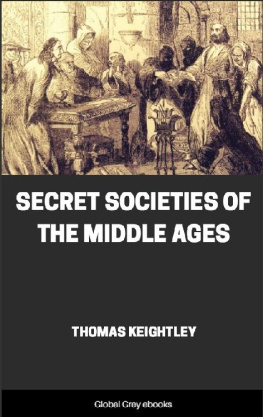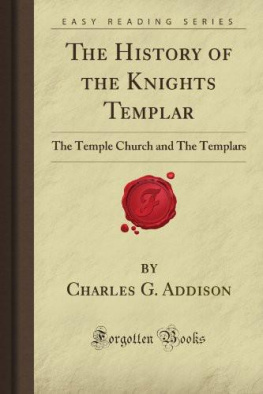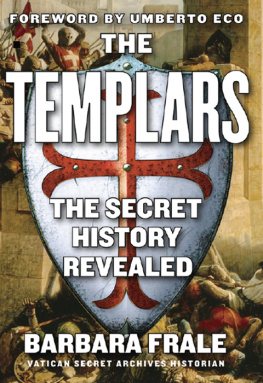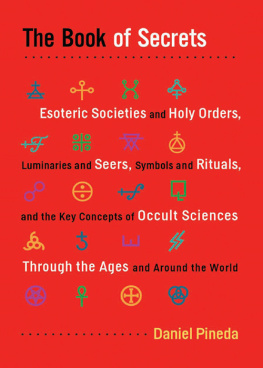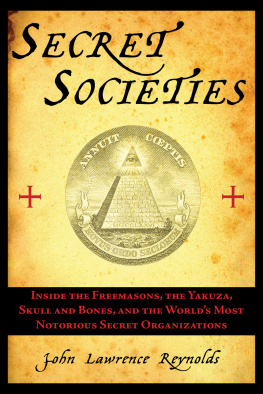Keightley - Secret societies of the Middle Ages : the Assassins, the Templars & the Secret Tribunals of Westphalia
Here you can read online Keightley - Secret societies of the Middle Ages : the Assassins, the Templars & the Secret Tribunals of Westphalia full text of the book (entire story) in english for free. Download pdf and epub, get meaning, cover and reviews about this ebook. City: Boston, year: 2005, publisher: Weiser Books, genre: History. Description of the work, (preface) as well as reviews are available. Best literature library LitArk.com created for fans of good reading and offers a wide selection of genres:
Romance novel
Science fiction
Adventure
Detective
Science
History
Home and family
Prose
Art
Politics
Computer
Non-fiction
Religion
Business
Children
Humor
Choose a favorite category and find really read worthwhile books. Enjoy immersion in the world of imagination, feel the emotions of the characters or learn something new for yourself, make an fascinating discovery.

Secret societies of the Middle Ages : the Assassins, the Templars & the Secret Tribunals of Westphalia: summary, description and annotation
We offer to read an annotation, description, summary or preface (depends on what the author of the book "Secret societies of the Middle Ages : the Assassins, the Templars & the Secret Tribunals of Westphalia" wrote himself). If you haven't found the necessary information about the book — write in the comments, we will try to find it.
Keightley: author's other books
Who wrote Secret societies of the Middle Ages : the Assassins, the Templars & the Secret Tribunals of Westphalia? Find out the surname, the name of the author of the book and a list of all author's works by series.
Secret societies of the Middle Ages : the Assassins, the Templars & the Secret Tribunals of Westphalia — read online for free the complete book (whole text) full work
Below is the text of the book, divided by pages. System saving the place of the last page read, allows you to conveniently read the book "Secret societies of the Middle Ages : the Assassins, the Templars & the Secret Tribunals of Westphalia" online for free, without having to search again every time where you left off. Put a bookmark, and you can go to the page where you finished reading at any time.
Font size:
Interval:
Bookmark:

This edition first published in 2005 by
Red Wheel/Weiser, LLC
York Beach, ME
With offices at:
368 Congress Street
Boston, MA 02210
www.redwheelweiser.com
Introduction to this edition copyright 2005 Red Wheel/Weiser, LLC
All rights reserved. No part of this publication may be reproduced or transmitted in any form or by any means, electronic or mechanical, including photocopying, recording, or by any information storage and retrieval system, without permission in writing from Red Wheel/Weiser, LLC. Reviewers may quote brief passages. Originally published in 1846 by M. A. Nattali, London.
Cover art is a detail from the Bayeux Tapestry, 11th century. Used by special permission of the City of Bayeux, France. The two horsemen that appear on the cover are in reverse orientation from the original tapestry.
Library of Congress Cataloging-in-Publication Data available upon request
Introduction typeset in AGaramond by Kathryn Sky-Peck
TCP
12 11 10 09 08 07 06 05
8 7 6 5 4 3 2 1
Thomas Keightley (1789-1872) was an extraordinarily prolific Irish-born scholar and writer who could read twenty different languages. He attended Trinity College in Dublin, but because of ill health, he did not join the Irish bar. He moved to London in 1824 to begin his literary career. His first solo work, Fairy Mythology, originally published anonymously in 1828 (and still in print), is said to have been praised by Jacob Grimm. Secret Societies of the Middle Ages was first published in 1837 anonymously and, according to the Dictionary of National Biography, against his will. It was reprinted at least three times over the next ten years.
I discovered Keightley only after I wrote The Templars and the Assassins: The Militia of Heaven. I was surprised indeed to find how similar in structure our books were. While many works on secret societies include short essays on the medieval Muslim Assassins and the Christian Knights Templar, both Keightley and I study and compare the two orders in greater detail.
Keightley's sophistication and erudition are unique for his day. His was virtually the first book in English to discuss a full history of the Assassins. A primary reference for him was Joseph von Hammer-Purgstall (1774-1856) whose book The History of the Assassins (1818) had been solely available in German. (Keightley mentions here that an English translation, published in 1835, was released just as he was finishing his book.) Hammer-Purgstall is impossibly hostile to both the Assassins and the Templars. That Keightley could rise above the judgmental cultural attitude of his time is remarkable. He was clearly a man of vast learning and deep reflection, ahead of his time as a historian.
Further proof of this is the contemporary relevance of this classic work. Today we are engaged in what I believe may accurately be described as the modern-day Crusades. That war of cultures between Christianity and Islam that shook the world a thousand years agowhen Christian battled Muslim for possession and control of the holy sites on which both their religions were foundedhas reemerged as the central theme of modern life for millions, if not billions, of people worldwide. This book helps shed light on the roots of that conflict.
The Assassins and the Templars were mirror images of one another. The Templars were unique to Christianity. Parallels might be drawn to King David's battle with Goliath. In this case, the forces of darkness represented by Goliath and the Philistines arose to threaten the forces of light represented by David and the Israelis. Young David killed in service to a higher religious ideal. He could be accused of breaking the sixth Commandment, Thou shalt not kill, yet he killed for the Lord. David's slaying of Goliath was an act of holy obedience. While he may have broken the Commandment, he obeyed his God. On this type of reasoning did the overall military campaign of the Crusades depend.
St. Bernard of Clairvaux (1090-1153) acted as the spiritual guide of the Knights Templar Order and promoted it to widespread acceptance. He was the most powerful Catholic cleric of his age and has been called the Conscience of Christendom. Advisor to popes and kings, that which Bernard supported thrived, that which he opposed did not. In 1135, he wrote his famous letter of spiritual instruction to the knight-monks of the fledgling Order, In Praise of the New Knighthood, addressed to Templar founder Hughes de Payens. This powerful proclamation laid out the conceptual basis of the spiritual ideal of the warrior-monk. St. Bernard wrote of the Templar warrior vowed to the service of the Church: If he kills malicious men, he is not a murderer under these circumstances, I say that he is murderer of wickedness and a champion of Christ.
The average Crusader was a secular knight doing good deeds for the salvation of his soul in service to the visions of his spiritual guide, the Pope. He could, in every other way, be a worldly individualprone to drinking, bragging, treachery, lechery, and general unruliness. In the case of the Templar knight, the situation was completely different. The Templars were monks who exercised their religious devotion through force of arms. They were holy warriors, substituting the rigors of simplicity and poverty for the trumpery and ostentatiousness of the silk-clad, jewel-bedecked, secular knight whose lust for his Lady was often dressed in the romanticized idealism of chivalry.
The medieval chivalric ideal of the Divine Feminine represented a cultural watershed. Celebrated in the songs and poems of troubadours and embodied by the mounted, armored knight, chivalry exalted women in Christian culture for the first time since the birth of the religion from its male-oriented Jewish parent. It was a welcome advance indeed. However, the Templars took the idealization of the feminine to a higher realm altogether. The Patroness of the Order was the Virgin Mary, Queen of Heaven, Mother of God. Service to this ideal called forth a physical chastity from the Templar warrior-monk, lest he lose his greater focus and be distracted by an illusion of that higher love, to waste his devotion on a lesser reflection of the ultimate feminine archetype to whom he aspired.
The Assassins were a less foreign idea for Islam than the Templars were to Christianity. Jihad, the principle of spiritual battle, was an established concept; in fact it has been called the Sixth Pillar of Islam. The Prophet spread the religion of Islam through the power of the sword. War was a part of religious duty, especially for the early Muslim. The Assassins, however, were the first monastic military Order within Islam. Their use of the dagger in service to the higher welfare of their community was a departure from the idea that the campaign against the infidels exempted Islam from battles between Muslims. The Assassins declared themselves apart from all, Muslims included. Their mission was to spread their teaching both outside of and within Islam. All who did not accept the doctrine of the Imamate of Nizar were unbelievers, the infidels against whom Jihad might properly be waged. (The Assassins are more properly known as the Nizari Ismailis.) To an Assassin, an observant Muslim could be an unbeliever.
Their use of assassination as a technique was also unique. The Assassins have been called the world's first terrorists. Their strategy was to selectively target those individuals who threatened their communityfor example, hostile political rulers, noble advisors who counseled policies against the community, generals and other highranking military commanders who attacked them, or religious and educational leaders who publicly preached against or taught against the sect. They quite successfully created widespread fear among those who opposed them.
Font size:
Interval:
Bookmark:
Similar books «Secret societies of the Middle Ages : the Assassins, the Templars & the Secret Tribunals of Westphalia»
Look at similar books to Secret societies of the Middle Ages : the Assassins, the Templars & the Secret Tribunals of Westphalia. We have selected literature similar in name and meaning in the hope of providing readers with more options to find new, interesting, not yet read works.
Discussion, reviews of the book Secret societies of the Middle Ages : the Assassins, the Templars & the Secret Tribunals of Westphalia and just readers' own opinions. Leave your comments, write what you think about the work, its meaning or the main characters. Specify what exactly you liked and what you didn't like, and why you think so.


